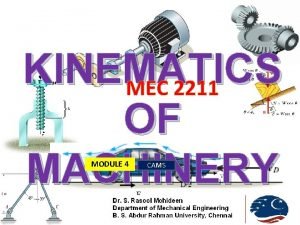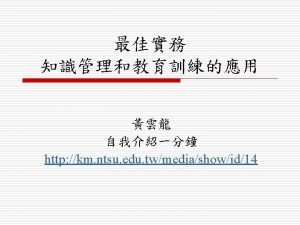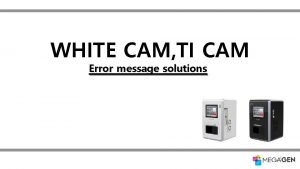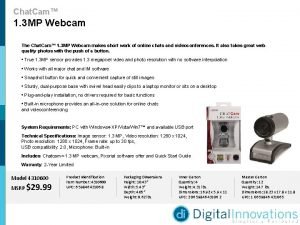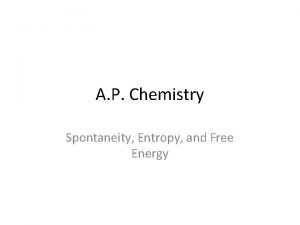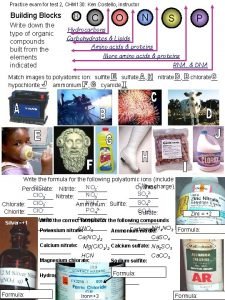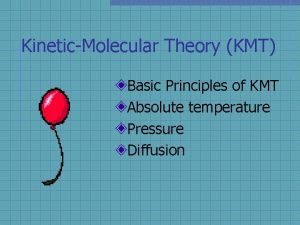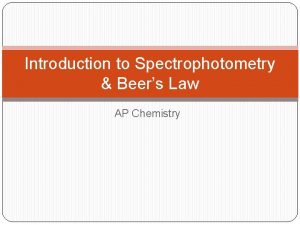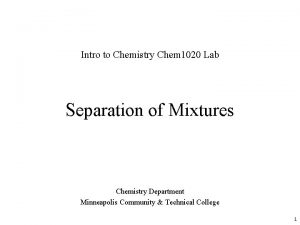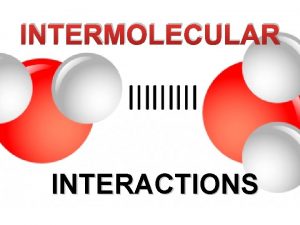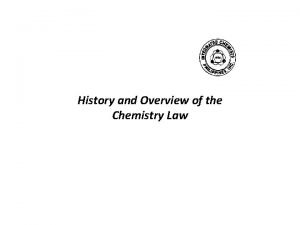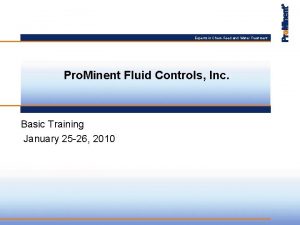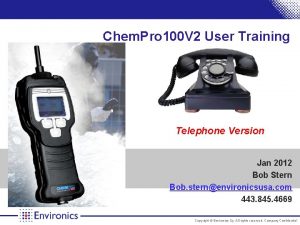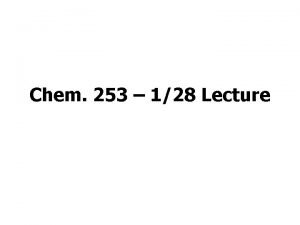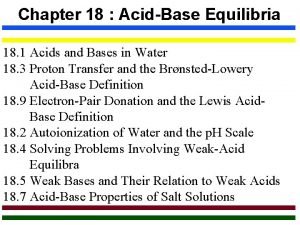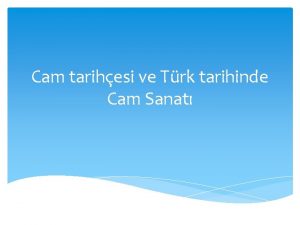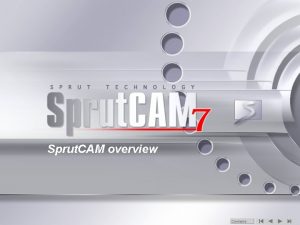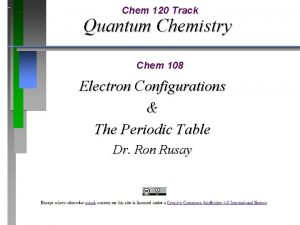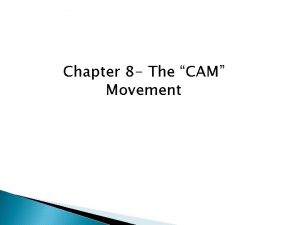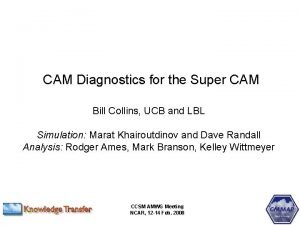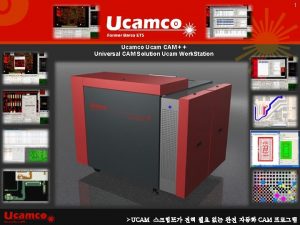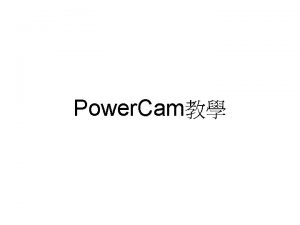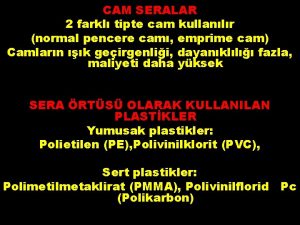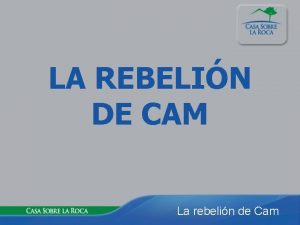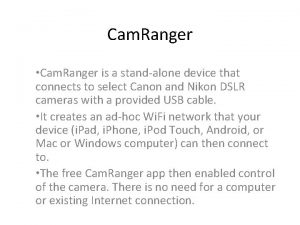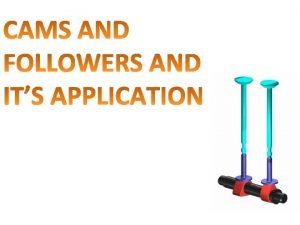Chem Cam What is Chem Cam Chemistry and



























- Slides: 27

Chem. Cam

What is Chem. Cam? • Chemistry and Camera • The Chem. Cam is the instrument providing remote analysis capability. • As the name implies, Chem. Cam is two different instruments combined as one: 1) a Laser-Induced Breakdown Spectrometer (LIBS) 2) a Remote Micro-Imager (RMI) • LIBS provides elemental compositions of rock and soil, while RMI will give high resolution images of sampling areas of rocks and soil.

How does it work? • Chem. Cam fires a laser (green line) in a series of pulses at a target. • Chem. Cam’s laser is powerful, but it is still invisible to human eye. • Electrons within the target becomes excited and emit light. The resulting flash of light (dashed green line) is clearly visible to human eye.

How does it work? • Chem. Cam receives this light with built-in telescope. and it is sent down an optical fiber to the body of the rover. • A spectrometer “reads” the light and identifies the types of atoms within the target. • Chem. Cam will be able to distinguish different elements because each chemical element has its own unique “fingerprint. ”

Objectives • Chem. Cam addresses four of the five MSL mission objectives, including : (1) characterize the geology of the landing region. (2) investigate planetary processes relevant to past habitability. (3) assess the biological potential of a target environment. (4) search for materials that would present toxic hazards to humans.

Types of investigations • • rapid remote rock identification dust removal soil and pebble composition surveys quantitative analysis, incl. trace elements detection of water/hydration Depth profile of rock weathering layers Geomorphology and imaging science

LIBS • The LIBS instrument uses powerful laser pulses, focused on a small spot on target rock and soil samples within 7 m of the rover, to ablate atoms and ions in electronically excited states from which they decay, producing lightemitting plasma. • The power density needed for LIBS is > 10 MW/mm^2, which is produced on a spot in the range of 0. 3 to 0. 6 mm diameter using focused, ~14 m. J laser pulses of 5 nanoseconds duration. • The plasma light is collected by a 110 mm diameter telescope and focused onto the end of a fiber optic cable.

LIBS • The fiber carries the light to three dispersive spectrometers which record the spectra over a range of 240 - 850 nm at resolutions from 0. 09 to 0. 30 nm in 6144 channels. • Typical rock and soil analyses yield detectable quantities of Na, Mg, Al, Si, Ca, K, Ti, Mn, Fe, H, C, O, Li, Sr, and Ba.

Advantages of LIBS • Remote elemental analysis with no sample preparation • Ability to remove dust and weathering layers with repeated laser pulses trained on the same spot • Simultaneous analysis of many elements • Low detection limits for a number of minor and trace elements, including Li, Sr, and Ba • Rapid analysis; one laser shot can constitute an analysis, though many spectra are often averaged for better statistics, still only taking a few seconds • Small analysis spot size of < 0. 6 mm diameter • Ability to identify water and/or hydrated minerals

RMI • Its main objective is to remotely determine the elemental composition of soil and rock. • It is also the main tool to check the focusing of the laser. • when focused at infinity, the camera has a resolution of about 2 millimeters per pixel. This gives the RMI the highest resolution of the camera.

RMI • The heart of the RMI instrument is the flight qualified CCD and associated electronics. • The 1024 x 1024 pixel CCD has been qualified to an operating temperature range of -120 to +30ºC. • In the flight-qualified set-up, it consumes 1. 5 W, and has 10 bit/pixel resolution. • It has an algorithm for auto-selecting exposure times by taking images at four different exposure times and selecting the image that maximizes the pixels.

Operation Sequence

Operation sequence 1) Thermo-electric cooler (TEC) is turned on to cool the detectors. 2) Functional Self-Test: an aliveness test initiated at the beginning of every Chem. Cam turn-on. It can be executed during the cruise and right after the first instrument turn-on following landing. This mode sets all sub-systems in their default mode and checks basic interfaces between subsystems. 3) Laser warm-up: The laser operates best at -10° to 0° C. Normally the box holding the laser is at -40° C. Up to 15 minutes are needed to warm the laser before operations.

Operation sequence 4) Focusing: A laser pointer is turned on, illuminating the target with monochromatic light. The focus stage is scanned while the signal is monitored at the correct wavelength by a detector. 5) For a typical rock analysis scenario a full 1024 x 1024 pixel image is taken prior to LIBS analysis.

Operation sequence 6) LIBS Data Acquisition: The laser is fired in a rapid series of shots while the spectrometer collects spectra. The laser can operate at 1 -10 Hertz, with a nominal repetition rate of 3 Hertz (shots per second). 6) Post-LIBS Image: Typically, an image of the laser spot will be taken subsequent to LIBS analysis, as mentioned above.

Chem. Cam Suit fig.

Mast Unit • The Mast Unit focuses on a target, generates a series of laser pulses, and collects light for the LIBS analysis. It also takes images with the RMI. It is mounted atop the MSL mast to benefit from the mast’s pointing capability. The Mast Unit is divided into four subsystems : 1. Laser 2. RMI 3. Telescope 4. Electronics box

Telescope & electronics • The telescope is required to 1) concentrate the laser beam onto the target, 2) collect laser-induced plasma light, and 3) obtain the image for the RMI. • The telescope has a fixed primary mirror and a moving secondary mirror used to focus. • The 110 millimeter diameter primary mirror collects return light, which is focused into the optical fiber for LIBS and onto the RMI CCD. • The mast electronics box contains all front-end electronics (FEE) for the LIBS laser, focus laser stage, micro-imager, and focus stage.

Telescope • the main functional requirements are: 1) deliver greater than 10 megawatts per square millimeter to targets 1. 5 -7 meters distant. 2) collect plasma light from 240 -850 nanometers within a 300 micron optical fiber.

Body unit • the Body Unit contains : - an optical demultiplexer - three spectrometers - a data processing unit - a power buffer - Rover interface

Spectrometer • The Chem. Cam spectrometers consist of three separate units covering separate spectral ranges. • The three ranges are 240 -336 nanometers, 380 -470 nanometers, and 470 -850 nanometers, designed to meet the spectral resolution and range requirements. • A fiber optic cable is used to bring light from the telescope to a demultiplexer, which splits the light into three spectral ranges for the spectrometer, optimizing the amount of light sent to each spectrometer. • The three spectrometers are nearly identical.

Fiber and other cabling • Cabling between the Mast and Body Units consists of a) a digital line between the DPU and the Mast front-end electronics box, b) a dedicated line between the RMI front-end electronics and the DPU, c) a line providing unregulated power, and d) a fiber optic cable providing LIBS light to the spectrometers. • The fiber has a fused silica single-core 300 microns in diameter.

DPU and interface • The Chem. Cam Body Unit contains an electronics box with a power supply board at the bottom, two DPU boards, and two boards for the spectrometer functions. • The DPU is in full control of the entire Chem. Cam at all times as dictated by mission commands, and performs the following functions: 1) to accept, store and decode commands, 2) to configure all subsystems, 3) to control operational modes(focusing the optics, taking images, firing of the pulsed laser, reading the data from the spectrometers and imager) 4) to process and compress the image and spectral data to transfer to the Rover Computer.

List of Commands CCAM_POWER_ON : It is used to turn on the Chem. Cam. CCAM_POWER_OFF: It is used to turn off the Chem. Cam. CCAM_COOLER_ON : It is used to turn on the cooler. It is turn on after laser fire. CCAM_COOLER_OFF : It is used to turn off cooler. CCAM_SET_FOCUS: It is used to focus the telescope on the identified object.

List of commands-2 • CCAM_LASER_ON : It is used to turn on laser beam. • CCAM_LIBS_WARM : It is used to warm LIBS. • CCAM_FIRE_LASER : It is used to fire the laser beam to focused object. • CCAM_LASER_OFF : It is used to turn off laser beam. • CCAM_CWL_WARM : It is used to warm • CWL(continuous-wave laser).

Constraints • Distance between Chem. Cam and object is 1. 5 to 7 meters. • Rover and Arm must not be moving when Chem. Cam is turn on. • Chem. Cam, normally operating temperature range is – 40 °c to +20 °c. • The laser operates best at -10 to 0 °c. • LIBS cannot fire laser >5 minutes continuously. • Up to 15 minutes are needed to warm the laser before the operations.

Constraints • The RMI taking very high resolution images of targets within about 10 meters of the rover. • RMI needed power of 1. 5 watts. • The laser is capable of providing > 3000 shots per sol.
 Wedge and flat cam
Wedge and flat cam Ntsu eeclass
Ntsu eeclass Cam ti cam
Cam ti cam Cam 2 cam chat
Cam 2 cam chat Ib chemistry functional groups
Ib chemistry functional groups Organic vs inorganic chemistry
Organic vs inorganic chemistry Chapter 19 acids bases and salts worksheet answers
Chapter 19 acids bases and salts worksheet answers Entropy ap chem
Entropy ap chem Iannonechem
Iannonechem Ap chemistry unit 7
Ap chemistry unit 7 Types of intermolecular forces
Types of intermolecular forces Chm 130 chapter 12 practice problems answer key
Chm 130 chapter 12 practice problems answer key Eth prop but pent hex
Eth prop but pent hex Kmt chem
Kmt chem January 2009 chemistry regents answers
January 2009 chemistry regents answers Introduction to spectrophotometry
Introduction to spectrophotometry Chem 1020
Chem 1020 Chem ufl
Chem ufl Chemistry law hazard pay
Chemistry law hazard pay Gen chem review for ochem
Gen chem review for ochem Chem 109
Chem 109 Chemfeed
Chemfeed E-chem portal
E-chem portal Chem 260 umich
Chem 260 umich Chempro 100i training
Chempro 100i training Chem 253
Chem 253 Solubility equilibria chem worksheet 18-7
Solubility equilibria chem worksheet 18-7 Specific heat chem worksheet 16-1
Specific heat chem worksheet 16-1
